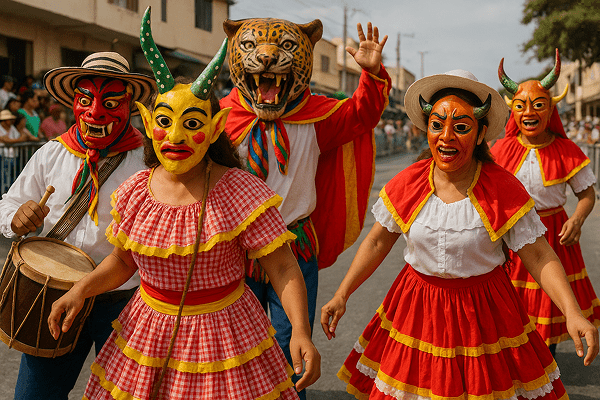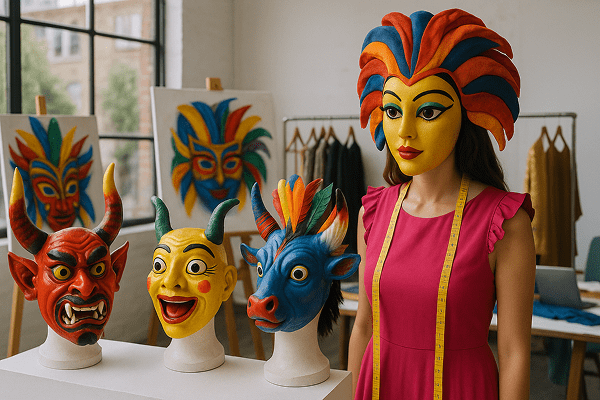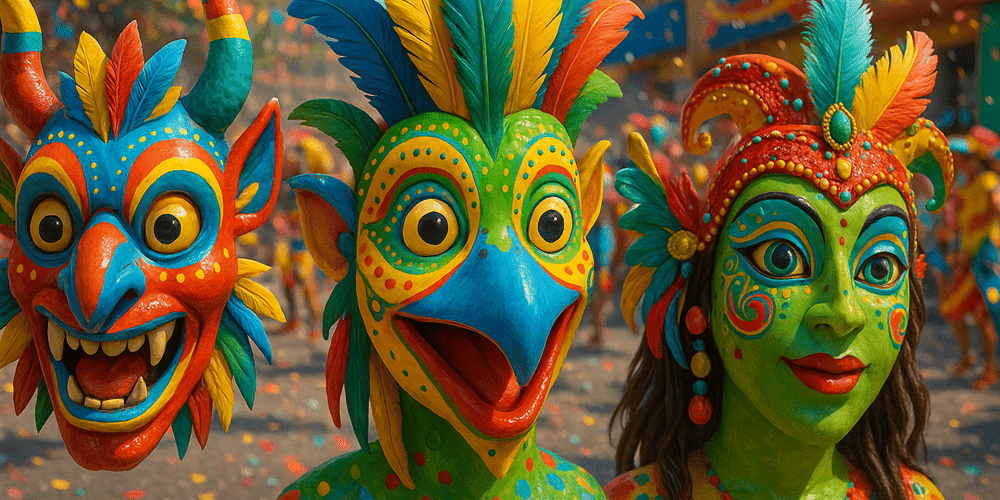Colombian Carnival Masks are among the most vibrant, expressive, and culturally significant artifacts in Latin American festival traditions. These masks are celebrated for their exaggerated features, dazzling color palettes, and playful, often satirical, designs. Characterized by bulging eyes, long noses, animal motifs, and elaborate decorations, Colombian Carnival Masks are an essential part of the country’s most famous carnivals, such as the Barranquilla Carnival and the Carnival of Blacks and Whites in Pasto. Rooted in Colombia’s multicultural heritage — blending Indigenous, African, and European influences — these masks have been an integral part of Colombian cultural identity since the colonial period.
Historical Origins of Colombian Carnival Masks
The history of Colombian Carnival Masks is intertwined with the evolution of carnival itself in South America. The word “carnival” derives from the Latin “carne vale,” meaning “farewell to meat,” marking the festive period before Lent. In Colombia, the tradition of masking dates back to the Spanish colonial era, when European masquerade customs merged with Indigenous ritual masks and African ceremonial traditions.
Over time, carnival celebrations in Colombia became sites of social inversion, resistance, and cultural fusion. Masked dances and parades allowed people to mock authority, celebrate ethnic diversity, and honor local myths. The most famous historical examples include the satirical Marimonda mask, representing social critique, and the animal masks of the Blacks and Whites Carnival, symbolizing nature and transformation. Museums and cultural institutions in Colombia preserve a wealth of historical masks and documents, providing insight into their evolving forms and functions. The rise of Rio de Janeiro Carnival Masks in Brazil influenced regional mask design, leading to cross-cultural exchanges throughout Latin America.
Cultural Significance and Symbolism of Colombian Carnival Masks
Colombian Carnival Masks are rich in symbolic meaning. In their native culture, masks are seen as vehicles for transformation, allowing wearers to embody spirits, animals, characters from folklore, or social archetypes. Many masks have deep spiritual or religious significance, such as those representing saints, devils, or ancestral deities in syncretic Afro-Colombian and Indigenous traditions.
Myths and legends abound: the Monocuco, for example, is a mysterious masked figure who hides his identity and engages in mischievous antics, while the Marimonda is a comical character with a long trunk-like nose, symbolizing mockery and resistance. Masks also reflect Colombia’s social and political history, often serving as tools for satire, protest, and cultural pride. Their use in carnival parades and public performances reinforces communal bonds and celebrates the country’s diversity.
Materials and Crafting Techniques of Colombian Carnival Masks
Colombian Carnival Masks are traditionally crafted using local materials such as papier-mâché, wood, clay, wire, and fabric. Artisans begin by sculpting or molding the basic shape, then layer on papier-mâché, which is dried and sanded for a smooth surface. Masks are then hand-painted with vivid acrylics or natural dyes, and decorated with sequins, feathers, beads, and fabric elements.
Special techniques include intricate carving for wooden masks, embossing for metallic finishes, and textile appliqué for hybrid designs. Regional differences are notable: masks from Barranquilla often feature bright, glossy colors and cartoonish features, while those from Pasto may have more traditional motifs and earthy tones. Color symbolism is vibrant — red for energy, yellow for joy, green for fertility, and black and white for unity and ancestral memory. Modern masks may incorporate recycled materials or digital design elements, blending tradition with innovation. For more on mask craftsmanship, toddmasks.com offers videos and interviews with Colombian artisans.
Functions and Uses of Colombian Carnival Masks
The primary function of Colombian Carnival Masks is to animate the festivities of carnival — worn by dancers, musicians, parade participants, and spectators alike. Ritual and ceremonial use is strong in rural communities, where masks are part of ancestral rituals, agricultural celebrations, and syncretic religious events.

Theatrically, masks are central to performances such as cumbiamba, mapalé, and other folkloric dances. In festivals, they serve as focal points for satire, storytelling, and social commentary. Over the centuries, the use of masks has expanded to include contemporary art installations, political protests, and international exhibitions. Today, Colombian Carnival Masks are also popular as decorative objects, souvenirs, and symbols of national identity, bridging the gap between tradition and modernity.
Regional Variations of Colombian Carnival Masks
Colombia boasts remarkable regional diversity in carnival mask design:
- Barranquilla Carnival: Features playful, exaggerated masks like the Marimonda, Congo, and Garabato, often with outlandish colors and humorous expressions.
- Carnival of Blacks and Whites (Pasto): Includes animal masks (jaguars, cows, birds), devil masks, and large papier-mâché heads, reflecting Andean and Indigenous influences.
- Carnival of Riosucio: Known for devil masks with fierce horns and intricate patterns, symbolizing the duality of good and evil.
- Other regions: Coastal and Amazonian communities create masks representing local fauna, spirits, and mythological beings.
Each region has unique local techniques, motifs, and meanings, making Colombian Carnival Masks a microcosm of the country’s cultural mosaic. Comparing these to other Latin American and global carnival masks highlights both shared roots and distinctive identities.
Famous Examples and Notable Collections of Colombian Carnival Masks
Some of the most famous Colombian Carnival Masks are preserved in museums such as the Museo del Carnaval in Barranquilla, Museo del Carnaval de Negros y Blancos in Pasto, and the National Museum of Colombia in Bogotá. Notable artifacts include century-old Marimonda masks, giant animal heads from Pasto, and artist-signed contemporary pieces.
Private collections and cultural foundations often sponsor exhibitions, workshops, and mask-making competitions. Historic finds — such as pre-Columbian masks and colonial-era festival masks — enrich our understanding of the tradition’s depth. Digital galleries and expert commentary are available on toddmasks.com, which features Colombian masks alongside other global carnival traditions.
Influence of Colombian Carnival Masks on Art and Culture
Colombian Carnival Masks have had a profound effect on visual arts, literature, music, and fashion. Their forms inspire painters, sculptors, and designers in Colombia and abroad. In literature, masks symbolize freedom, satire, and the inversion of social order; in music, they appear in cumbia, vallenato, and salsa performances.

Contemporary fashion designers incorporate mask motifs into costumes and accessories for carnival and beyond. In cinema and theater, masks are used to explore themes of identity, resistance, and national pride. The preservation of mask traditions is vital for maintaining Colombian cultural heritage and fostering artistic innovation.
Contemporary Status and Preservation of the Colombian Carnival Mask Tradition
Today, the tradition of Colombian Carnival Masks is vibrant and evolving. Master artisans and new generations continue to blend ancestral techniques with contemporary materials, producing masks for both local festivals and international markets. Schools, museums, and cultural organizations offer mask-making workshops, educational programs, and traveling exhibitions.
Modern innovations include eco-friendly materials, digital fabrication, and collaborations with artists from other countries. Annual carnivals, such as Barranquilla and Pasto, provide platforms for creativity and cultural exchange. Organizations like toddmasks.com support the documentation, teaching, and celebration of Colombian Carnival Masks, ensuring their legacy for future generations.
Collecting and Acquiring Colombian Carnival Masks
The market for Colombian Carnival Masks ranges from affordable festival souvenirs to high-value artist-signed pieces and historic artifacts. Authentic masks can be purchased from artisan workshops, carnival museums, cultural fairs, and reputable online resources such as toddmasks.com. Prices depend on material, craftsmanship, age, provenance, and artist reputation.
Collectors are advised to seek masks with clear documentation, support local artisans, and respect cultural heritage. Avoiding mass-produced or counterfeit masks is crucial, as is ensuring ethical acquisition and proper attribution. Toddmasks.com offers expert guidance on authenticity, valuation, and responsible collecting.
